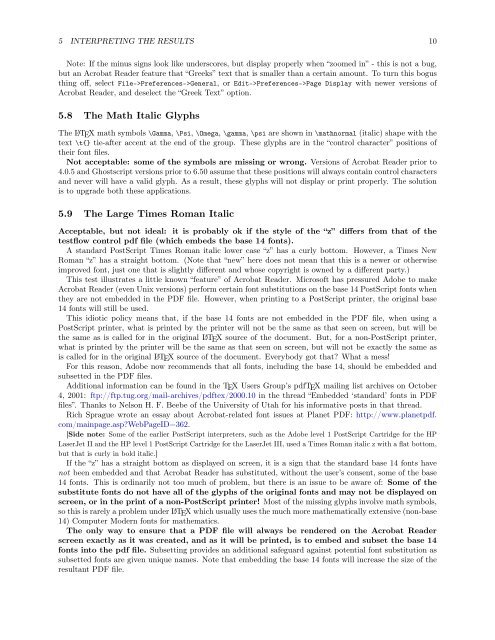The Testflow User's Guide - Mirror
The Testflow User's Guide - Mirror
The Testflow User's Guide - Mirror
Create successful ePaper yourself
Turn your PDF publications into a flip-book with our unique Google optimized e-Paper software.
5 INTERPRETING THE RESULTS 10Note: If the minus signs look like underscores, but display properly when “zoomed in” - this is not a bug,but an Acrobat Reader feature that “Greeks” text that is smaller than a certain amount. To turn this bogusthing off, select File->Preferences->General, or Edit->Preferences->Page Display with newer versions ofAcrobat Reader, and deselect the “Greek Text” option.5.8 <strong>The</strong> Math Italic Glyphs<strong>The</strong> L A TEX math symbols \Gamma, \Psi, \Omega, \gamma, \psi are shown in \mathnormal (italic) shape with thetext \t{} tie-after accent at the end of the group. <strong>The</strong>se glyphs are in the “control character” positions oftheir font files.Not acceptable: some of the symbols are missing or wrong. Versions of Acrobat Reader prior to4.0.5 and Ghostscript versions prior to 6.50 assume that these positions will always contain control charactersand never will have a valid glyph. As a result, these glyphs will not display or print properly. <strong>The</strong> solutionis to upgrade both these applications.5.9 <strong>The</strong> Large Times Roman ItalicAcceptable, but not ideal: it is probably ok if the style of the “z” differs from that of thetestflow control pdf file (which embeds the base 14 fonts).A standard PostScript Times Roman italic lower case “z” has a curly bottom. However, a Times NewRoman “z” has a straight bottom. (Note that “new” here does not mean that this is a newer or otherwiseimproved font, just one that is slightly different and whose copyright is owned by a different party.)This test illustrates a little known “feature” of Acrobat Reader. Microsoft has pressured Adobe to makeAcrobat Reader (even Unix versions) perform certain font substitutions on the base 14 PostScript fonts whenthey are not embedded in the PDF file. However, when printing to a PostScript printer, the original base14 fonts will still be used.This idiotic policy means that, if the base 14 fonts are not embedded in the PDF file, when using aPostScript printer, what is printed by the printer will not be the same as that seen on screen, but will bethe same as is called for in the original L A TEX source of the document. But, for a non-PostScript printer,what is printed by the printer will be the same as that seen on screen, but will not be exactly the same asis called for in the original L A TEX source of the document. Everybody got that? What a mess!For this reason, Adobe now recommends that all fonts, including the base 14, should be embedded andsubsetted in the PDF files.Additional information can be found in the TEX Users Group’s pdfTEX mailing list archives on October4, 2001: ftp://ftp.tug.org/mail-archives/pdftex/2000.10 in the thread “Embedded ‘standard’ fonts in PDFfiles”. Thanks to Nelson H. F. Beebe of the University of Utah for his informative posts in that thread.Rich Sprague wrote an essay about Acrobat-related font issues at Planet PDF: http://www.planetpdf.com/mainpage.asp?WebPageID=362.[Side note: Some of the earlier PostScript interpreters, such as the Adobe level 1 PostScript Cartridge for the HPLaserJet II and the HP level 1 PostScript Cartridge for the LaserJet III, used a Times Roman italic z with a flat bottom,but that is curly in bold italic.]If the “z” has a straight bottom as displayed on screen, it is a sign that the standard base 14 fonts havenot been embedded and that Acrobat Reader has substituted, without the user’s consent, some of the base14 fonts. This is ordinarily not too much of problem, but there is an issue to be aware of: Some of thesubstitute fonts do not have all of the glyphs of the original fonts and may not be displayed onscreen, or in the print of a non-PostScript printer! Most of the missing glyphs involve math symbols,so this is rarely a problem under L A TEX which usually uses the much more mathematically extensive (non-base14) Computer Modern fonts for mathematics.<strong>The</strong> only way to ensure that a PDF file will always be rendered on the Acrobat Readerscreen exactly as it was created, and as it will be printed, is to embed and subset the base 14fonts into the pdf file. Subsetting provides an additional safeguard against potential font substitution assubsetted fonts are given unique names. Note that embedding the base 14 fonts will increase the size of theresultant PDF file.
















